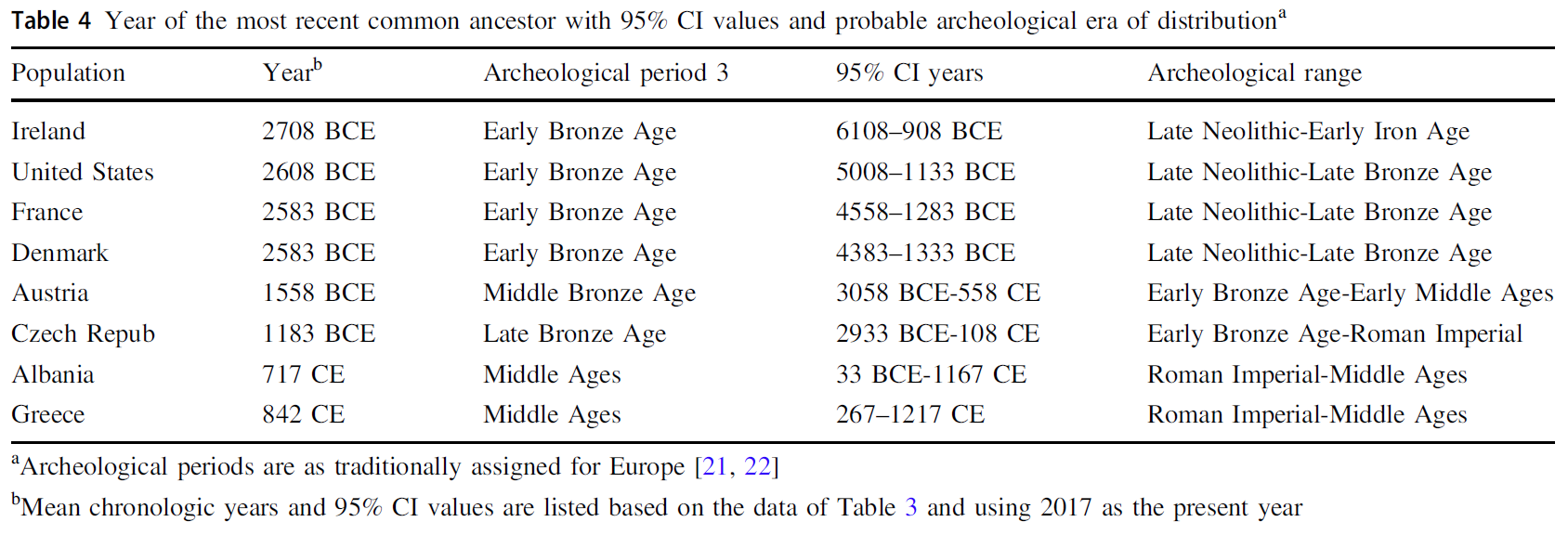New paper (behind paywall) Estimating the age of p.(Phe508del) with family studies of geographically distinct European populations and the early spread of cystic fibrosis, by Farrell et al., European Journal of Human Genetics (2018).
Interesting excerpts (emphasis mine):
Our results revealed tMRCA average values ranging from 4725 to 1175 years ago and support the estimates of Serre et al. (3000–6000 years ago) [11], rather than Morral et al. (52,000 years ago) [6], but the latter figure was challenged by Kaplan et al. [26] because of disagreement with assumptions used in their calculations. In addition, the tMRCA values from western European regions reported herein refine the results of Fichou et al. [7] from a study of Breton CF patients in which the Estiage analysis suggested that the most common recent ancestor lived 115 generations ago. That tMRCA value, however, may have underestimated the age of p.(Phe508del) in Brittany due to consideration of all the haplotypes, even those that were reconstructed with ambiguities, as well as a potential bias associated with consanguinity due to including both haplotypes in homozygous families. In the more stringent Estiage analyses reported herein, those potential biases were avoided for all populations, leading to estimates of the oldest tMCRA values corresponding to the Early Bronze Age in western Europe, which is generally agreed to begin around 3000 BCE. This finding extends our results from a direct investigation of aDNA in teeth from Iron Age burials near Vienna around 350 BCE and allow us to conclude that p.(Phe508del) was present in that region long before then. More specifically, in the Austrian families studied, the Estiage data revealed a mean tMCRA value of 3575 years ago, which converts to 1558 BCE (Middle Bronze Age) [22].
Perhaps most remarkably, the estimated ages of p.(Phe508del) in the three western European regions (France, Ireland, and Denmark) were similar with closely overlapping 95% CI values. This observation is also in line with previously documented spatial autocorrelograms expressing genetic and geographical distance for these populations [24]. Such data provide more insight about the ancient origin of CF in our judgment—both when and where—and lead us to propose that CFTR p.(Phe508del) is derived from ancestors who lived in western Europe during the Bronze Age, as early as 2700 BCE, and that its relatively rapid dissemination occurred because of human migrations around the northwestern Atlantic trading routes [21] and then towards central and eastern Europe [22]. Diffusion from northwestern to central Europe in approximately 1000 years is consistent with the prominent Bronze Age migrations evident in the archeological record [21, 22] and from genomic studies of aDNA [27]. On the other hand, we are assuming a discrete origin of the principal CF-causing variant, but it is possible that p.(Phe508del) arose more than once or earlier, and then reached western Europe subsequently through Neolithic migrations.
[About Bell Beakers] (…) More specifically, their distinctive Bell Beaker pottery appeared and spread across western and central Europe beginning around 3000–2750 BCE and then disappeared between 2200 and 1800 BCE [22, 29]. Their migrations are linked to the advent of western and central European metallurgy, as they manufactured and traded metal goods, especially weapons, while traveling over long distances [30]. Most relevant to our study is the evidence that they migrated in a direction and over a time period that fits well with the pattern of tMRCA data we found for the p.(Phe508del) variant. Olalde et al. [29] have shown that both migration and cultural transmission played a major role in diffusion of the “Beaker Complex” and led to a “profound demographic transformation” of Britain after 2400 BCE. Moreover, the cultural elements that unite the widely distributed Beaker folk are so obvious that some have considered them a distinct ethnicity of Bronze Age people [33].
From our results, we propose the novel concept that large scale, long term west-to-east migrations of the Bell Beaker Europeans [22, 28–30] during the Bronze Age, could explain the dissemination of p.(Phe508del) in Europe and its documented northwest-to-southeast gradient [4].In fact, our tMRCA data show a temporal gradient also.
As you can see from the references, they consulted with Barry Cunliffe (or people accepting his theory), who is obsessed with Bell Beakers expanding Celtic languages from the British Isles. He is like the British equivalent of Danish scholar Kristian Kristiansen, and his obsession with Corded Ware = Indo-European (and Germanic = CWC Denmark), immutable no matter what genetic results might show.
The funny thing is, the interpretation of the paper is probably right. From what we can see in the data, it is quite possible that the disease spread with expanding Bell Beakers…only it spread from the East group in Hungary, i.e. from east to west. The regional difference in TMRCA and apparent west—east cline would point to the different expansions of affected lineages in the corresponding regions, and not to an origin in the British Isles.
Related
- Oldest bubonic plague genome decoded in Srubna ca. 3800 YBP
- Phylogeny of leprosy, relevant for prehistoric Eurasian contacts
- Ancient DNA study reveals HLA susceptibility locus for leprosy in medieval Europeans
- Stone Age plague accompanying migrants from the steppe, probably Yamna, Balkan EBA, and Bell Beaker, not Corded Ware
- The Caucasus a genetic and cultural barrier; Yamna dominated by R1b-M269; Yamna settlers in Hungary cluster with Yamna
- Steppe and Caucasus Eneolithic: the new keystones of the EHG-CHG-ANE ancestry in steppe groups
- East Bell Beakers, an in situ admixture of Yamna settlers and GAC-like groups in Hungary
